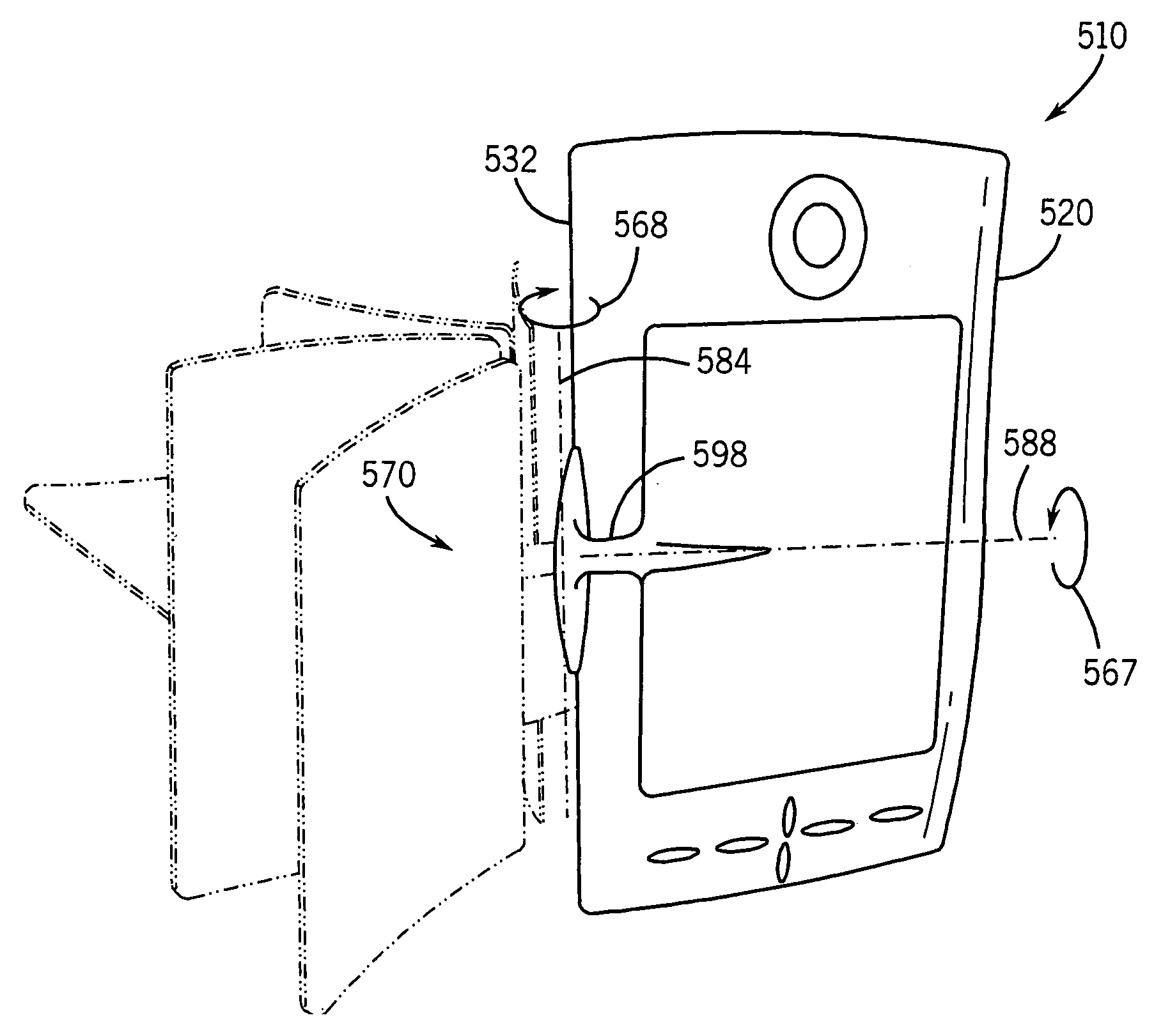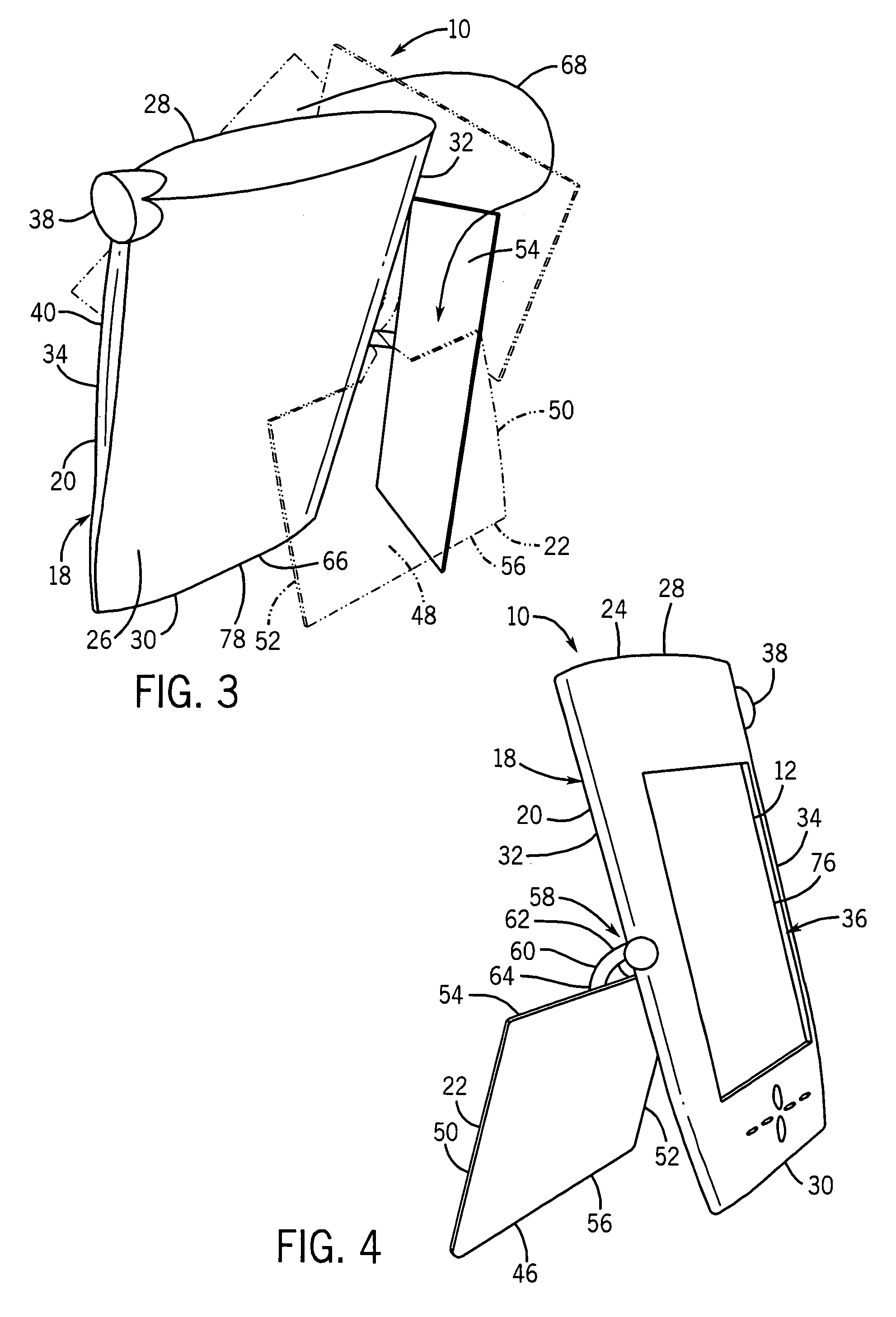Encasement for handheld computer
a handheld computer and encasement technology, applied in the field of handheld computers, can solve the problems of increased footprint, disadvantageous pivot arrangement (or book open style), and relatively complex multiple linkage structure of 360° hinge arrangemen
- Summary
- Abstract
- Description
- Claims
- Application Information
AI Technical Summary
Benefits of technology
Problems solved by technology
Method used
Image
Examples
second embodiment
[0057]Referring now to FIGS. 5–8, a handheld computer 110 is shown. For brevity, the description of handheld computer 110 will be generally limited to its differences relative to handheld computer 10 described above. For convenience, elements of handheld computer 110 that are substantially similar to corresponding elements of handheld computer 10 will be identified by the same reference numerals but preceded by a “1”.
[0058]Handheld computer 110 differs from handheld computer 10 described above in that proximal end 162 of arm 160 is pivotally coupled to left edge 132 of housing 120 at a location that is substantially below horizontal midline 176 of display 112 and housing 120. In addition, distal end 164 of arm 160 is fixedly coupled to left edge 154 of cover 122 at a lower location than described above for the attachment of arm 60 to cover 22. As a result, bottom edge 152 of cover 122 in the stand position does not lie substantially along vertical midline 178 of rear face 126 of hou...
third embodiment
[0059]Referring now to FIGS. 9–13, a handheld computer 210 is shown. For brevity, the description of handheld computer 210 will be generally limited to its differences relative to handheld computer 110 described above. For convenience, elements of handheld computer 210 that are substantially similar to corresponding elements of handheld computer 110 will be identified by the same reference numerals but preceded by a “2” instead of a “1”.
[0060]Handheld computer 210 differs from handheld computer 110 described above in that cover 222 when in the stand position is in a “portrait” orientation rather than a “landscape” as with cover 122. In particular, cover 222 in the stand position has top edge 250 resting on horizontal support surface 266 and corner 280 engaged with a well or recess 282 formed in rear face 226 of housing 220. With this arrangement, right edge 256 of cover 222 when in the stand position extends beyond vertical midline 278 of rear face 226 of housing 220. In a preferred...
fourth embodiment
[0061]Referring now to FIGS. 14–18, a handheld computer 310 is shown. For brevity, the description of handheld computer 310 will be generally limited to its differences relative to handheld computer 10 described above. For convenience, elements of handheld computer 310 that are substantially similar to corresponding elements of handheld computer 10 will be identified by the same reference numerals but preceded by a “3”.
[0062]Handheld computer 310 differs from handheld computer 10 described above in that proximal end 362 of arm 360 is pivotally coupled to the midpoint of bottom edge 330 of housing 320 rather than to the midpoint of left side edge 332 (as with handheld computer 10). As a result, cover 322 in the stand position has its inner surface 346 (rather than one of its edges) in contact with horizontal support surface 366.
[0063]In FIG. 18, arrow 368 shows cover 322 being moved from the closed position to the stand position by flipping cover 322 about an axis 384 extending along...
PUM
 Login to view more
Login to view more Abstract
Description
Claims
Application Information
 Login to view more
Login to view more - R&D Engineer
- R&D Manager
- IP Professional
- Industry Leading Data Capabilities
- Powerful AI technology
- Patent DNA Extraction
Browse by: Latest US Patents, China's latest patents, Technical Efficacy Thesaurus, Application Domain, Technology Topic.
© 2024 PatSnap. All rights reserved.Legal|Privacy policy|Modern Slavery Act Transparency Statement|Sitemap



